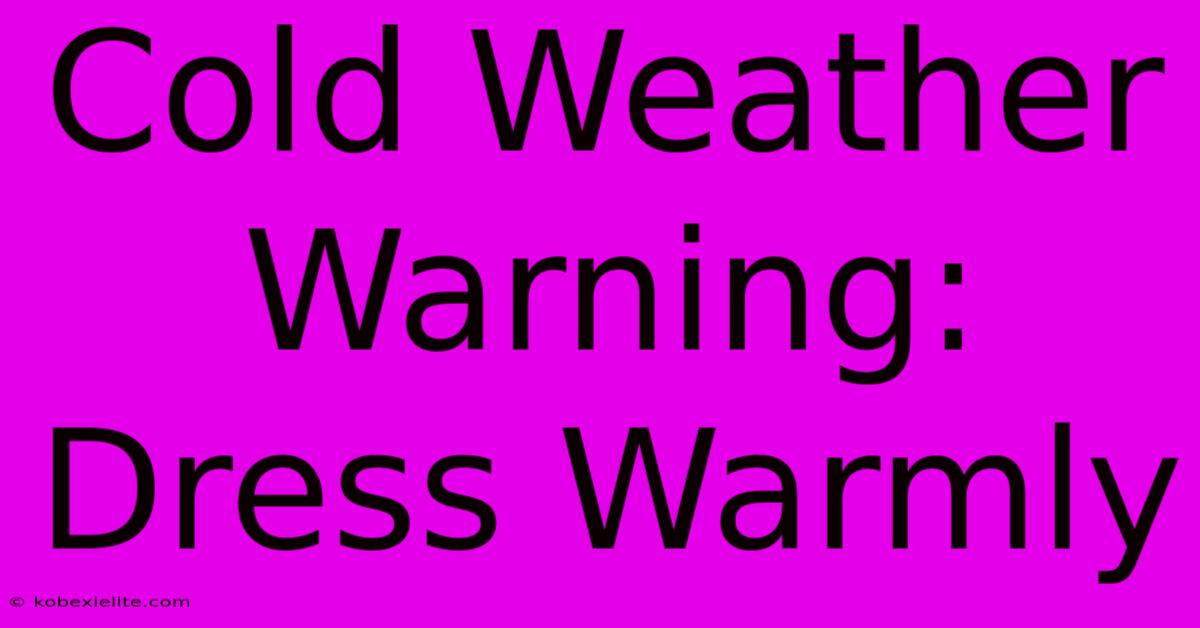Cold Weather Warning: Dress Warmly

Discover more detailed and exciting information on our website. Click the link below to start your adventure: Visit Best Website mr.cleine.com. Don't miss out!
Table of Contents
Cold Weather Warning: Dress Warmly to Stay Safe and Comfortable
Winter's chill can be a serious threat if you're not prepared. This isn't just about a little discomfort; exposure to extreme cold can lead to serious health problems like hypothermia and frostbite. This article provides crucial information on how to dress warmly and protect yourself from the dangers of cold weather.
Understanding the Risks of Cold Weather
Before diving into how to dress, let's understand the risks. Hypothermia occurs when your body loses heat faster than it can produce it, causing a dangerously low body temperature. Symptoms include shivering, confusion, drowsiness, and slurred speech. Frostbite, on the other hand, is damage to body tissue caused by freezing. It typically affects extremities like fingers, toes, ears, and nose. Recognizing these risks is the first step to staying safe.
Who is Most at Risk?
Certain individuals are more vulnerable to cold-related illnesses:
- Infants and young children: Their bodies haven't fully developed the ability to regulate temperature.
- Older adults: They may have reduced sensitivity to cold and underlying health conditions that increase their risk.
- People with chronic illnesses: Conditions like heart disease, diabetes, and peripheral artery disease can impair the body's ability to regulate temperature.
- People experiencing homelessness: Lack of access to adequate shelter and warm clothing puts them at significantly higher risk.
The Layering System: Your Best Defense Against the Cold
The key to staying warm in cold weather is layering. Think of it as creating a mini-climate around your body. Multiple layers trap warm air and provide insulation. Here's a breakdown of the ideal layering system:
1. Base Layer (Wicking Layer):
This layer sits directly against your skin. Its purpose is to wick away moisture (sweat) to prevent you from getting chilled. Avoid cotton, which absorbs moisture and stays wet. Instead, opt for synthetic materials like polyester or merino wool.
2. Mid Layer (Insulating Layer):
This layer traps warm air and provides insulation. Good choices include fleece jackets, sweaters, or down vests. The thickness of this layer should depend on the severity of the cold.
3. Outer Layer (Shell Layer):
This is your protective layer against wind, snow, and rain. A waterproof and windproof jacket or coat is essential. Look for features like a hood and adjustable cuffs to further minimize heat loss.
Beyond Clothing: Additional Tips for Staying Warm
Clothing is crucial, but other factors play a significant role in staying safe in cold weather:
- Protect your extremities: Wear hats, gloves, scarves, and warm socks. Your head, hands, and feet lose heat rapidly.
- Stay hydrated: Dehydration can increase your risk of hypothermia.
- Eat warm, nutritious meals: This helps your body generate heat.
- Limit alcohol consumption: Alcohol can interfere with your body's ability to regulate temperature.
- Be aware of the signs of hypothermia and frostbite: Seek medical attention immediately if you suspect either condition.
- Check weather forecasts regularly: Be prepared for sudden changes in temperature.
Cold Weather Clothing Checklist:
- Warm hat: Covers your head, preventing significant heat loss.
- Waterproof, windproof jacket: Shields you from the elements.
- Warm gloves or mittens: Keep your hands toasty.
- Warm socks (wool or synthetic): Crucial for preventing foot chill.
- Scarf or neck gaiter: Protects your neck and face from the wind.
- Waterproof boots: Keep your feet dry and warm.
Staying warm in cold weather isn't just about comfort; it's about safety. By understanding the risks, dressing appropriately, and following these tips, you can enjoy winter activities while protecting yourself from the dangers of extreme cold. Remember to always prioritize safety and seek help if needed.

Thank you for visiting our website wich cover about Cold Weather Warning: Dress Warmly. We hope the information provided has been useful to you. Feel free to contact us if you have any questions or need further assistance. See you next time and dont miss to bookmark.
Featured Posts
-
Rugby Sensory Space Unveiled
Feb 02, 2025
-
Senior Bowl Final Score And Results
Feb 02, 2025
-
Todd Leaves Nbc News Amid Trump Era
Feb 02, 2025
-
7 Dead 19 Injured In Philly Plane Crash
Feb 02, 2025
-
Wwe Royal Rumble 2025 Details
Feb 02, 2025
